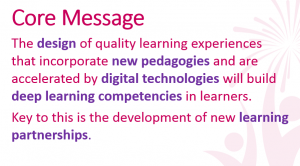Just yesterday I was looking back at notes from our first NPDL (New Pedagogies for Deep Learning) global meeting in Hong Kong in October 2013 and was struck as how far we’ve come, at individual, school, cluster and global levels. Perhaps a better choice of phrase might be “how deep we’ve gone”!
Our thinking, collectively, has sharpened and has given rise to rapidly iterative development of supporting resources at local and global levels.
Like any well designed learning activity, the NPDL framework, whilst focusing on impact at student level, allows schools multiple entry points. It offers opportunities for critical alignment to individual, network and systemic priorities. What has become most evident to me is the way the framework provides throughlines for practice, drawing together the streams of leadership, teaching and learning into a cohesive and highly relational model at conceptual and practical levels.
The schools I support have each focussed on how best to interpret and access the global model – again, as with a classroom task, there is great opportunity for personalised learning. Some have chosen to work on building teacher capacity – encouraging and developing innovative pedagogical practices. Others have taken the concept of Leveraging Digital, and referencing Mal Lee’s research around “Digital Normalisation” have shifted organisational practices (including teaching, learning, administration and leadership) to high levels of effect.
Many schools have focussed on the core practice of Collaboration, but not solely at student level. Indeed some of the most powerful work has been directed around the question “What would a highly and truly collaborative culture look like within and across staff at my school?” This hits at the NPDL foundational pillar of Learning Partnerships – the relationships between and among teachers, learners and community. I am constantly reminded of Michael Fullan’s observation in Motion Leadership that “nothing succeeds like collective capacity”, and I take great joy in seeing this in action as teachers and schools connect and work through challenges and opportunities, sharing common goals and aspirations.
I was talking with a colleague and NPDL school principal last month. Somehow we were contemplating the idea of a “Growth Mindset” – a term that seems to have great currency (at least in my twitter stream) at present. In one of those wonderful, rapid fire, exploratory conversations, something clicked, and one of us dropped the questions
“What if we had a DEPTH mindset?”
“What if we went slower to go deeper?”
So I wonder how we draw on Andy Hargreaves’ “Slow Learning”, or Steve Jacobs’ “white space for slow hunches?” I have a feeling that the initial complexity of our NPDL work has forced us to really evaluate school, network and systemic goals for learners and learning, and may have “slowed our thinking” to a point where we can now go deep into a dissection of why kids can’t wait for a different model of education. A model that makes the important measurable, not the measurable important. (Thanks Joanne and Jane).
 Deep Learning, and a Depth Mindset, like the mighty oak in the house next door to me, take time to grow. Perhaps we need to be explicitly conscious of time; to allow and make time to go deep as we lead and learn together, so like the oak, we can stand tall through tempest, holding fast to principles deeply rooted in the collective and powerful enough to grow through the ages.
Deep Learning, and a Depth Mindset, like the mighty oak in the house next door to me, take time to grow. Perhaps we need to be explicitly conscious of time; to allow and make time to go deep as we lead and learn together, so like the oak, we can stand tall through tempest, holding fast to principles deeply rooted in the collective and powerful enough to grow through the ages.











